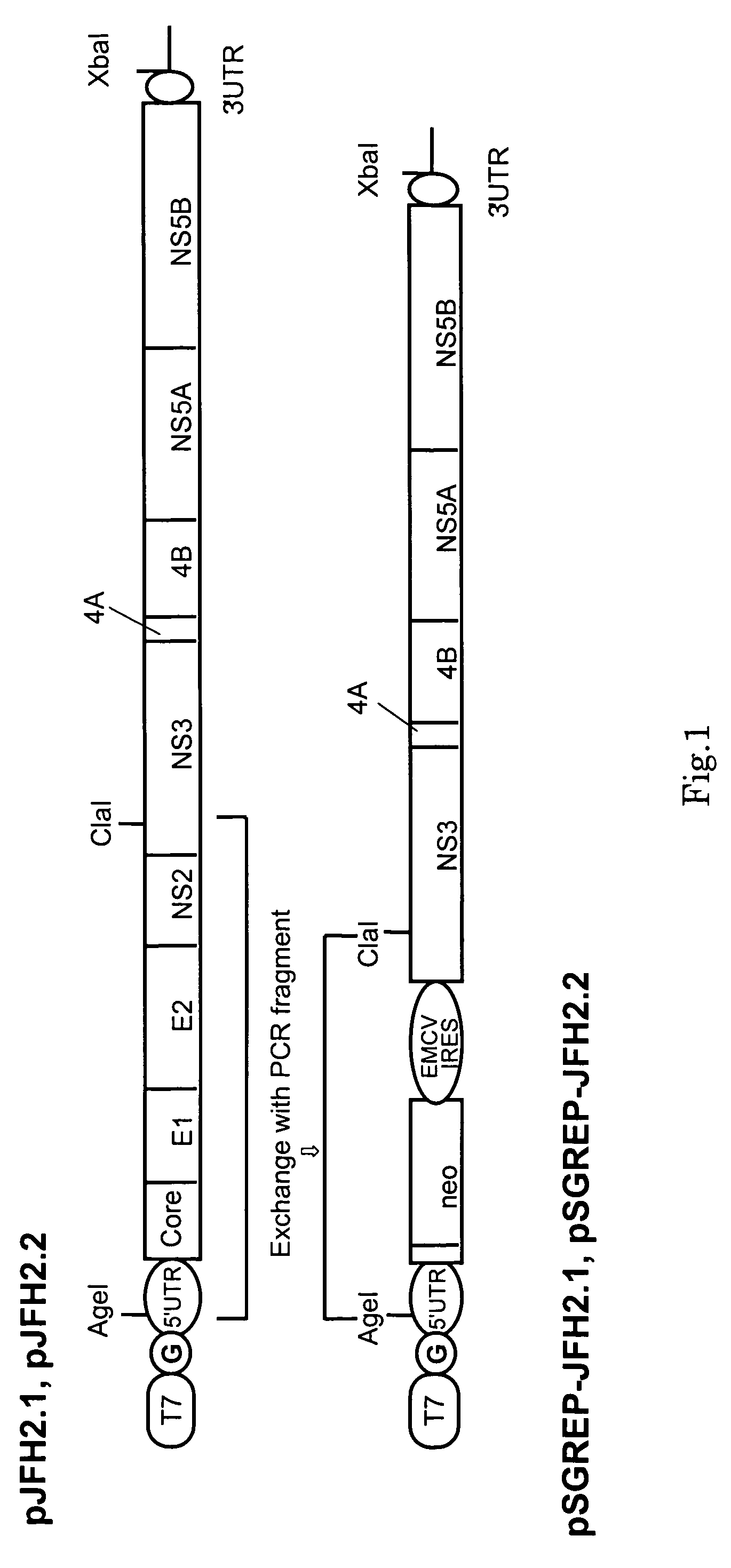Nucleic acid and gene derived from novel HCV strain and replicon-replicating cell using said gene
a technology of hcv and gene, applied in the field of nucleic acid and gene derived from a novel hcv strain and replicon-replicating cell using said gene, can solve the problems of difficult propagation of hcv, significant challenge in causal therapy, and half of patients who had the effect relapse, so as to increase the replication efficiency of replicon rna, the effect of increasing the replication efficiency and increasing the replication efficiency
- Summary
- Abstract
- Description
- Claims
- Application Information
AI Technical Summary
Benefits of technology
Problems solved by technology
Method used
Image
Examples
example 1
Replication of Replicon RNA
1. Construction of Expression Vector
[0091]DNAs corresponding to the whole regions of virus genomes of hepatitis C viruses, JFH-2.1 strain and JFH-2.2 strain, isolated from patients with fulminant hepatitis were obtained from JFH-2.1 and JFH-2.2 clones containing the full-genome-length cDNAs of the virus strains, and synthetic DNA of T7 RNA promoter sequence was attached to the 5′ end of each clone and then inserted into a plasmid, pUC19 plasmid. Hereinafter, the thus-constructed plasmid DNAs are referred to as pJFH-2.1 and pJFH-2.2, respectively. It should be noted that the creation of the above-described JFH-2.1 and JFH-2.2 clones was carried out according to a published report (Lehmann et al., Science, (1999)).
[0092]The structures of the thus-constructed plasmid DNAs, pJFH-2.1 and pJFH-2.2, are shown in the upper row of FIG. 1. “T7” indicates T7 RNA promoter, and “G” indicates dGTP inserted upstream of the 5′ ends of JFH-2.1 and JFH-2.2 and downstream of...
example 2
Establishment of Replicon-Replicating Cell Clones
[0097]For each of the synthetic replicon RNAs, rSGREP-JFH2.1 and rSGREP-JFH2.2 created in the example 1, 0.01 ng to 10 μg of the replicon RNA was mixed with total cellular RNA extracted from Huh7 cells to adjust the total RNA amount to 10 μg. Subsequently, the mixed RNA was introduced into Huh7 cells by electroporation. The Huh7 cells subjected to the treatment with electroporation were seeded in culture dishes and cultured for 16 hours to 24 hours, followed by addition of G418 (neomycin) into the dishes at various concentrations. Then, the culture was continued while changing the culture medium twice a week. After culturing for 21 days from the time of seeding, viable cells were stained with crystal violet. As the result, colony formation was confirmed as shown in FIG. 2.
[0098]For the cells that were transfected with rSGREP-JFH2.1 and rSGREP-JFH2.2 and showed colony formation, colonies of viable cells were further cloned from the cul...
PUM
| Property | Measurement | Unit |
|---|---|---|
| prothrombin time | aaaaa | aaaaa |
| prothrombin time | aaaaa | aaaaa |
| concentration | aaaaa | aaaaa |
Abstract
Description
Claims
Application Information
 Login to View More
Login to View More - R&D
- Intellectual Property
- Life Sciences
- Materials
- Tech Scout
- Unparalleled Data Quality
- Higher Quality Content
- 60% Fewer Hallucinations
Browse by: Latest US Patents, China's latest patents, Technical Efficacy Thesaurus, Application Domain, Technology Topic, Popular Technical Reports.
© 2025 PatSnap. All rights reserved.Legal|Privacy policy|Modern Slavery Act Transparency Statement|Sitemap|About US| Contact US: help@patsnap.com


